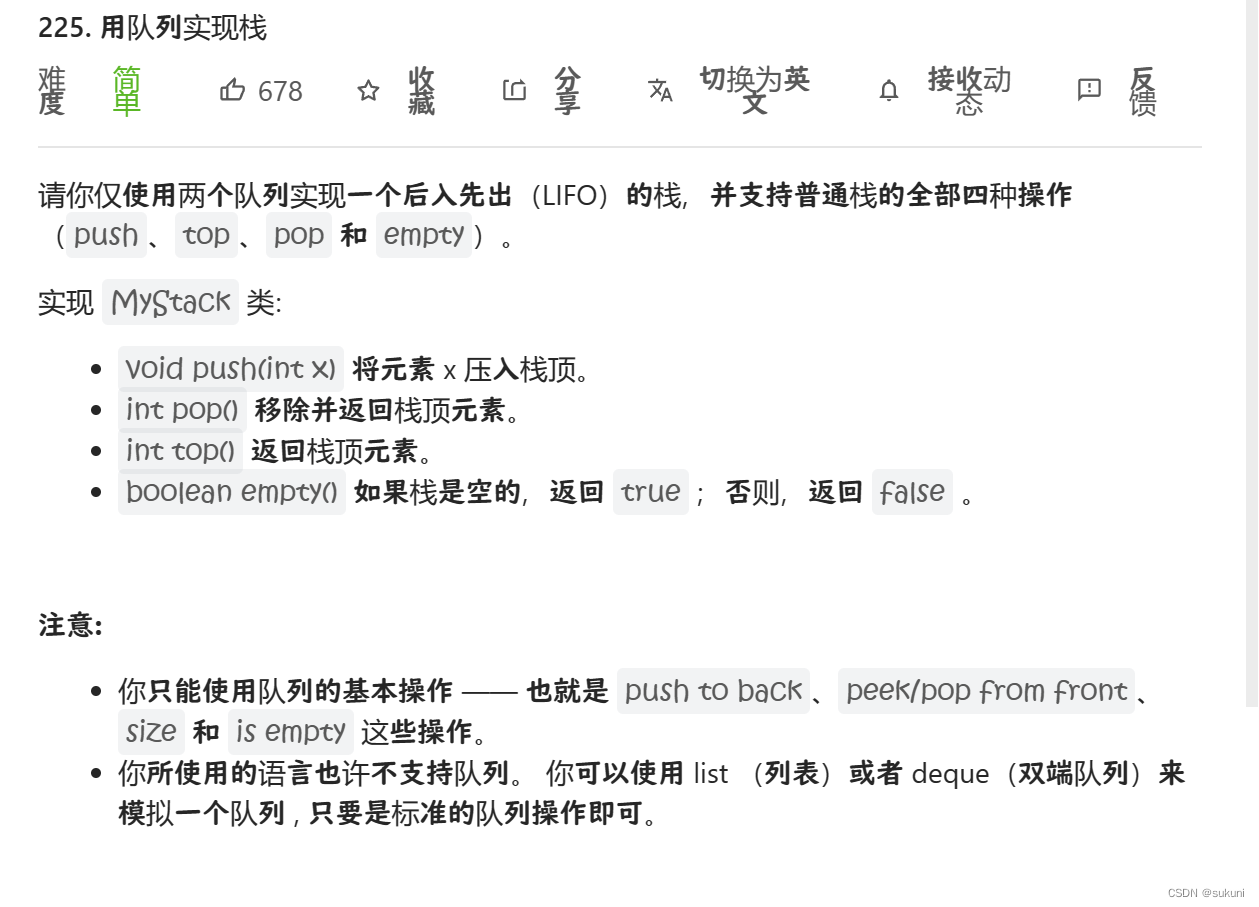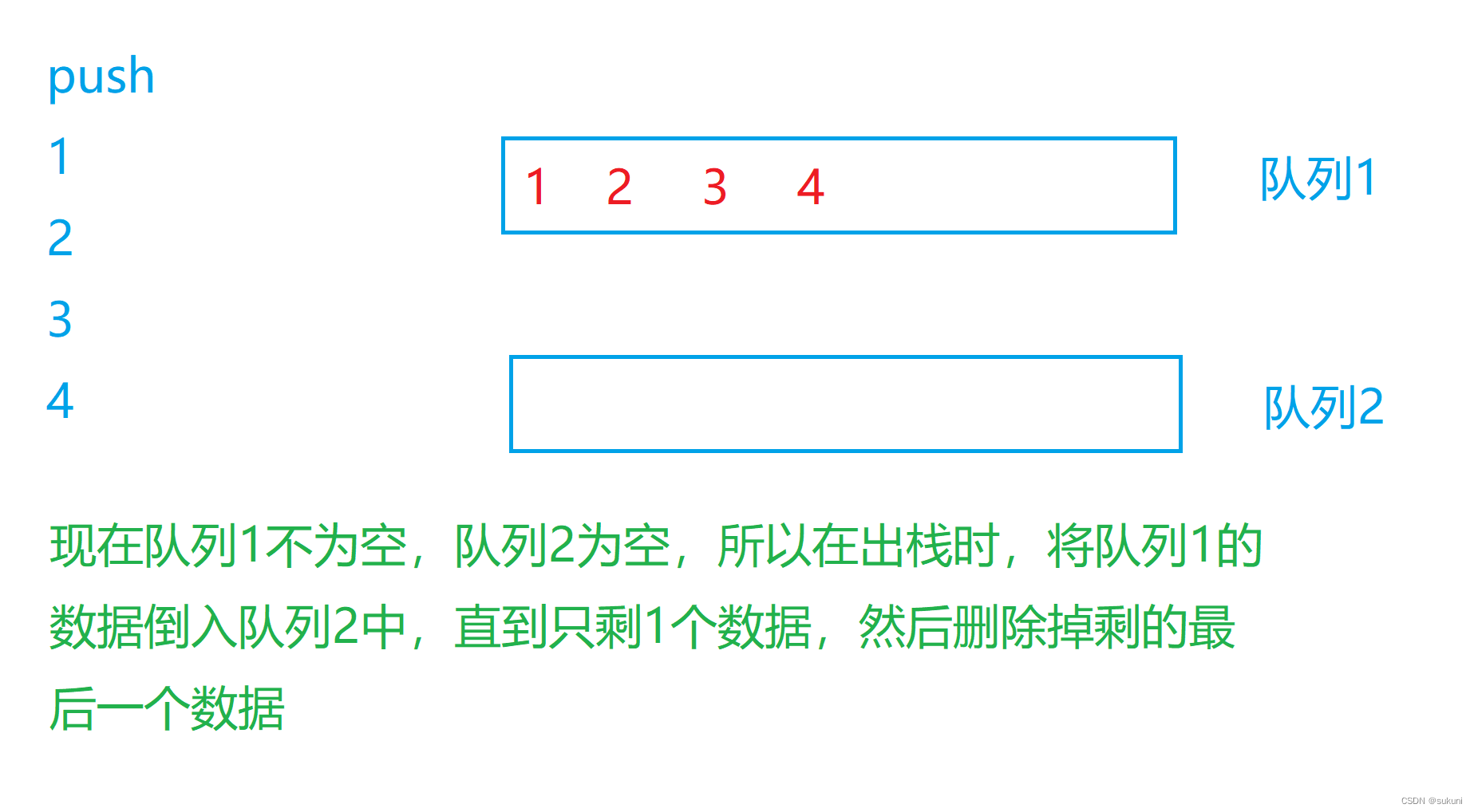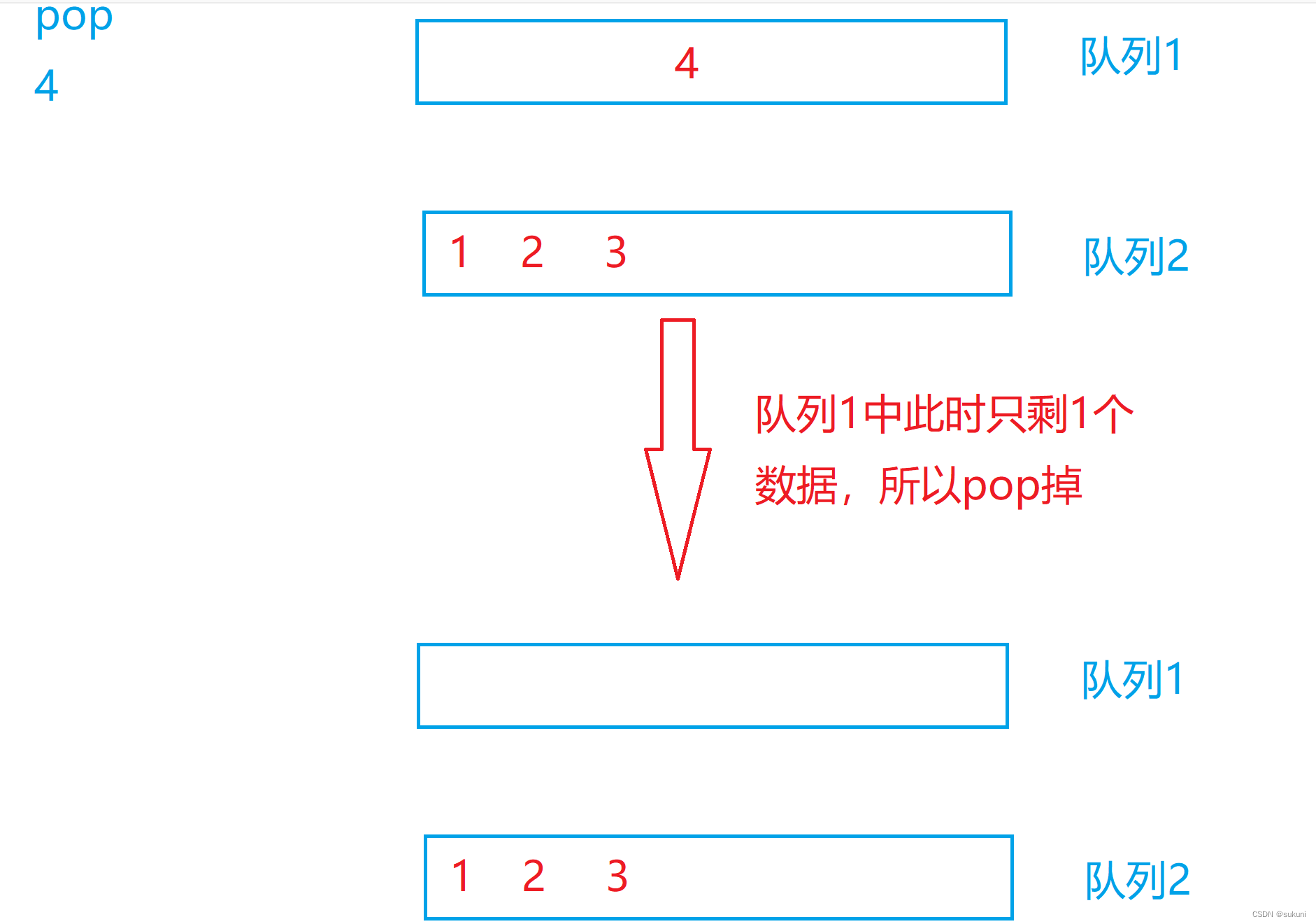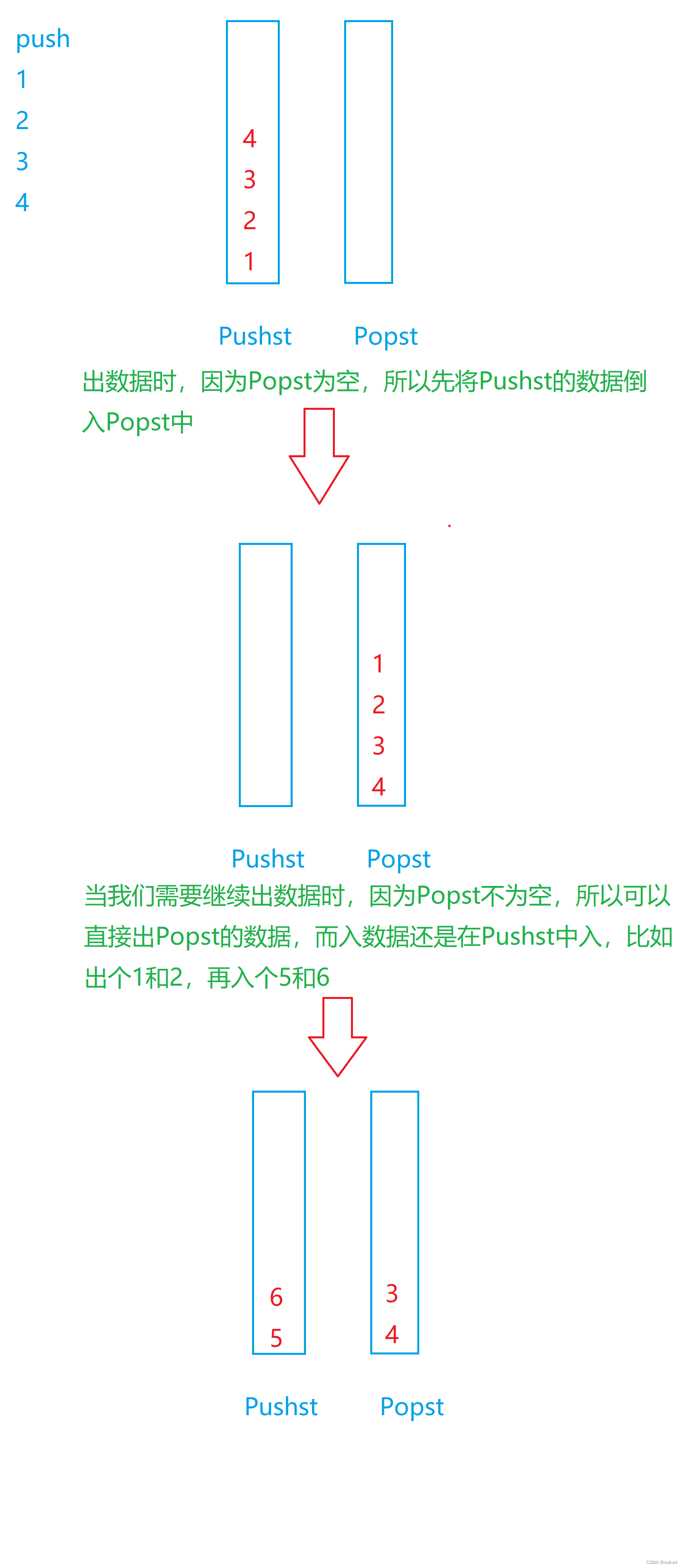【Leetcode】队列实现栈和栈实现队列
【Leetcode】队列实现栈和栈实现队列

aosei
发布于 2024-01-23 14:05:20
发布于 2024-01-23 14:05:20
一.【Leetcode225】队列实现栈
1.链接
2.题目再现

3.解法
这道题给了我们两个队列,要求去实现栈; 首先,我们要知道栈和队列的特征: 栈:后进先出,只能从栈顶入数据和出数据; 队列:先进先出,从队尾入数据,队头出数据;
根据这些特点,我们可以采用两边倒的方法来实现; 具体来说: 1.入栈时就是在不为空的队列插入数据,若两个队列都为空,就随便插入到一个队列中; 2.出栈时将不为空的队列的数据倒入为空的队列中,当不为空的队列就剩一个数据时,就停止向空队列倒数据,然后再删点那最后一个数据;


3.判空时,需要两个队列都为空,才算栈为空; 4.取栈顶元素即取不为空的队列的队尾元素,在取栈顶元素前要判断栈是否为空; 5.销毁栈时,要先销毁其中的两个队列,然后再销毁栈。
因为是用C语言实现的,所以得自己手搓个队列。
typedef int Qdatatype;
typedef struct QueueNode
{
struct QueeuNode* next;
Qdatatype data;
}QueueNode;
typedef struct Queue
{
QueueNode* head;
QueueNode* tail;
}Queue;
void Queueinit(Queue* pq)
{
assert(pq);
pq->head = NULL;
pq->tail = NULL;
}
void Queuedestroy(Queue* pq)
{
assert(pq);
QueueNode* cur = pq->head;
while (cur != pq->tail)
{
QueueNode* next = cur->next;
free(cur);
cur = next;
}
pq->head = pq->tail = NULL;
}
void Queuepush(Queue* pq, Qdatatype x)
{
assert(pq);
QueueNode* newnode = (QueueNode*)malloc(sizeof(QueueNode));
if (newnode == NULL)
{
perror("malloc fail");
exit(-1);
}
newnode->data = x;
newnode->next = NULL;
if (pq->head == NULL)
{
pq->head = pq->tail = newnode;
}
else
{
pq->tail->next = newnode;
pq->tail = newnode;
}
}
void Queuepop(Queue* pq)
{
assert(pq);
assert(pq->head);
QueueNode* next = pq->head->next;
if (pq->head->next == NULL)
{
free(pq->head);
pq->head = pq->tail = NULL;
}
else
{
free(pq->head);
pq->head = next;
}
}
Qdatatype Queuefront(Queue* pq)
{
assert(pq);
assert(pq->head);
return pq->head->data;
}
Qdatatype Queueback(Queue* pq)
{
assert(pq);
assert(Queuesize(pq) > 0);
return pq->tail->data;
}
int Queuesize(Queue* pq)
{
assert(pq);
int size = 0;
QueueNode* cur = pq->head;
while (cur != pq->tail->next)
{
size++;
cur = cur->next;
}
return size;
}
bool Queueempty(Queue* pq)
{
assert(pq);
return pq->head == NULL;
}
typedef struct
{
Queue q1;
Queue q2;
} MyStack;
MyStack* myStackCreate() {
MyStack*obj=(MyStack*)malloc(sizeof(MyStack));
if(obj==NULL)
exit(-1);
Queueinit(&obj->q1);
Queueinit(&obj->q2);
return obj;
}
void myStackPush(MyStack* obj, int x)
{
if(!Queueempty(&obj->q1))
{
Queuepush(&obj->q1,x);
}
else
{
Queuepush(&obj->q2,x);
}
}
int myStackPop(MyStack* obj) {
Queue*empty=&obj->q1;
Queue*noempty=&obj->q2;
if(!Queueempty(&obj->q1))
{
empty=&obj->q2;
noempty=&obj->q1;
}
while(Queuesize(noempty)>1)
{
Queuepush(empty,Queuefront(noempty));
Queuepop(noempty);
}
int front=Queuefront(noempty);
Queuepop(noempty);
return front;
}
int myStackTop(MyStack* obj) {
if(!Queueempty(&obj->q1))
{
return Queueback(&obj->q1);
}
else
{
return Queueback(&obj->q2);
}
}
bool myStackEmpty(MyStack* obj) {
return Queueempty(&obj->q1)&&Queueempty(&obj->q2);
}
void myStackFree(MyStack* obj) {
Queuedestroy(&obj->q1);
Queuedestroy(&obj->q2);
free(obj);
}二.【Leetcode232】栈实现队列
1.链接
2.题目再现

3.解法
这个的解法和上面的类似,只不过这个不用总是来回倒; 根据栈和队列的特征,我们会发现将一个栈中的数据倒入另一个栈时,数据的顺序刚好符合队列的要求,不需要再重复地倒数据,所以我们可以让一个栈专门用来入数据(Pushst),一个栈专门用来出数据(Popst),当我们要出数据而这个栈为空时,我们才将用来入数据的栈中的数据倒入用来出数据的栈 。 如图:

1.判空时,需要两个栈都为空,队列才为空; 2.返回队头数据时,和出数据的操作类似,只是不需要删除队头的数据,还有在之前要判断队列是否为空; 3.销毁队列前,要先销毁两个栈。
同样,因为是C语言,得先手搓个栈。
#define MR_CAP 5
typedef int STdatatype;
typedef struct Stack
{
STdatatype* arr;
int top;
int capacity;
}ST;
void Stackinit(ST* ps)
{
assert(ps);
ps->arr = (STdatatype*)malloc(MR_CAP * sizeof(STdatatype));
if (ps->arr == NULL)
{
perror("Stackinit malloc");
exit(-1);
}
ps->top = 0;
ps->capacity = MR_CAP;
}
void Stackdestroy(ST* ps)
{
assert(ps);
free(ps->arr);
ps->arr = NULL;
ps->top = 0;
ps->capacity = 0;
}
void Stackpush(ST* ps, STdatatype x)
{
assert(ps);
if (ps->top == ps->capacity)
{
STdatatype* tmp = (STdatatype*)realloc(ps->arr, ps->capacity * 2 * sizeof(STdatatype));
if (tmp == NULL)
{
perror("Stackpush realloc");
exit(-1);
}
else
{
ps->arr = tmp;
ps->capacity *= 2;
}
}
ps->arr[ps->top] = x;
ps->top++;
}
void Stackpop(ST* ps)
{
assert(ps);
assert(ps->top > 0);
ps->top--;
}
STdatatype Stacktop(ST* ps)
{
assert(ps);
return ps->arr[ps->top - 1];
}
int Stacksize(ST* ps)
{
assert(ps);
return ps->top;
}
bool Stackempty(ST* ps)
{
assert(ps);
if (ps->top == 0)
{
return true;
}
else
return false;
}
typedef struct {
ST Pushst;
ST Popst;
} MyQueue;
MyQueue* myQueueCreate() {
MyQueue*obj=(MyQueue*)malloc(sizeof(MyQueue));
if(obj==NULL)
exit(-1);
Stackinit(&obj->Pushst);
Stackinit(&obj->Popst);
return obj;
}
void myQueuePush(MyQueue* obj, int x) {
Stackpush(&obj->Pushst,x);
}
int myQueuePeek(MyQueue* obj) {
if(Stackempty(&obj->Popst))
{
while(!Stackempty(&obj->Pushst))
{
Stackpush(&obj->Popst,Stacktop(&obj->Pushst));
Stackpop(&obj->Pushst);
}
}
return Stacktop(&obj->Popst);
}
int myQueuePop(MyQueue* obj) {
int front=myQueuePeek(obj);
Stackpop(&obj->Popst);
return front;
}
bool myQueueEmpty(MyQueue* obj) {
return Stackempty(&obj->Pushst)&&Stackempty(&obj->Popst);
}
void myQueueFree(MyQueue* obj) {
Stackdestroy(&obj->Pushst);
Stackdestroy(&obj->Popst);
free(obj);
}本文参与 腾讯云自媒体分享计划,分享自作者个人站点/博客。
原始发表:2024-01-23,如有侵权请联系 cloudcommunity@tencent.com 删除
评论
登录后参与评论
推荐阅读
目录